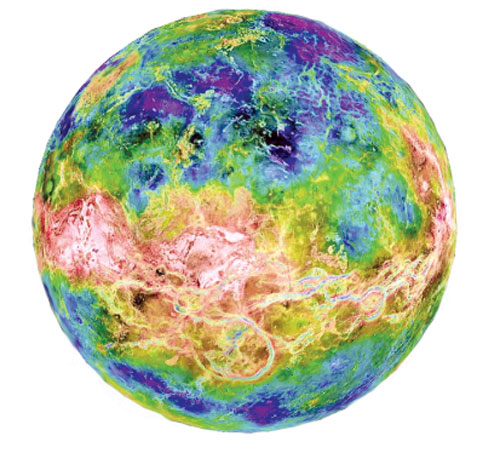Neptune has blue cloud cover
The planet Neptune was discovered on September 23, 1846. Neptune was
the first planet to get its existence predicted by mathematical
calculations before it was actually seen by a telescope.
Irregularities in the orbit of Uranus led French astronomer Alexis
Bouvard to suggest that the gravitational pull from another celestial
body might be responsible. German astronomer Johann Galle then relied on
subsequent calculations to help spot Neptune via telescope.
In accordance with all the other planets seen in the sky, this new
world was given a name from Greek and Roman mythology - Neptune, the
Roman god of the sea.
Physical characteristics

Neptune's cloud cover has an especially vivid blue tint that is
partly due to an as-yet-unidentified compound and the result of the
absorption of red light by methane in the planets mostly hydrogen-helium
atmosphere. Photos of Neptune reveal a blue planet, and it is often
dubbed an ice giant, since it has a thick, slushy fluid mix of water,
ammonia and methane ices under its atmosphere and is roughly 17 times
Earth's mass and nearly 58 times its volume. Neptune's rocky core alone
is thought to be roughly equal to Earth's mass.
Despite its great distance from the sun, which means it gets little
sunlight to help warm and drive its atmosphere, Neptune's winds can
reach up to 1,500 miles per hour (2,400 kilometres per hour), the
fastest detected yet in the solar system. These winds were linked with a
large dark storm that Voyager 2 tracked in Neptune's southern hemisphere
in 1989.
This oval-shaped, counterclockwise-spinning "Great Dark Spot" was
large enough to contain the entire Earth, and moved westward at nearly
750 miles per hour (1,200 kilometres per hour). This storm seemed to
have vanished when the Hubble Space Telescope later searched for it.
Hubble has also revealed the appearance and then fading of two other
Great Dark Spots over the last decade. New measurements performed by the
European Space Agency's Herschel infrared space telescope indicate that
a comet may have hit Neptune, the outer-most planet in our solar system,
two centuries ago.Neptune is the eighth and most distant planet from the
sun.
Its elliptical, oval-shaped orbit makes it keep an average distance
from the sun of almost 2.8 billion miles (4.5 billion kilometres), or
roughly 30 times as far away as Earth, making it invisible to the naked
eye. Neptune goes around the sun once roughly every 165 Earth years, and
completed its first orbit, since being discovered.
Every 248 years, Pluto moves inside Neptune's orbit for 20 years or
so, during which time it is closer to the sun than Neptune.
Nevertheless, Neptune remains the farthest planet from the sun, since
Pluto was reclassified as a dwarf planet in 2006
-Internet |


